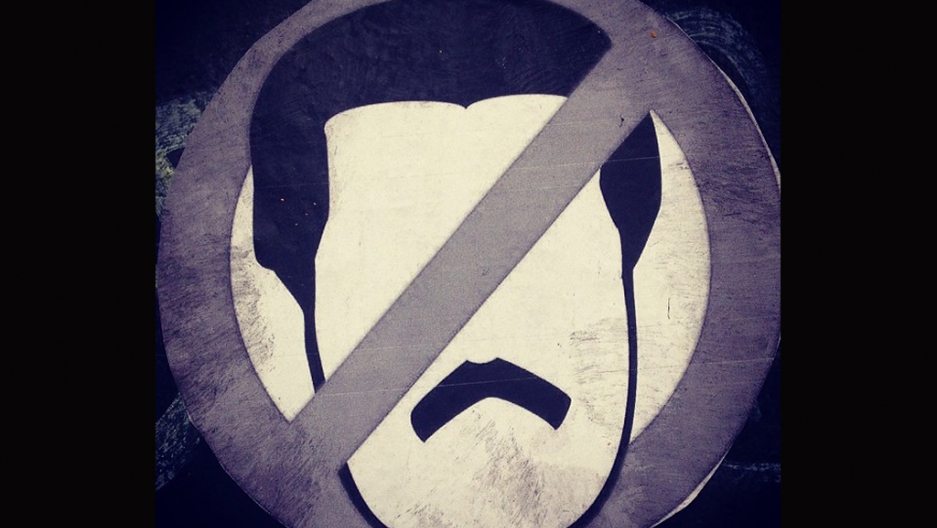This is what it actually looks like on the ground in Venezuela right now
Protesters have learned a thing or two from experience after three weeks of nightly rioting in Caracas's Chacao district.Those who come for “guarimba” (troublemaking) bring gas masks they craft out of empty juice bottles to cope with the police’s liberal use of tear gas. Protesters also smear toothpaste and vinegar on their faces, which is supposed to help ease the burn from the common crowd dispersal substance. Many residents of Chacao, a relatively upscale district known for opposition sympathies, stand at their windows while the mayhem unfolds in the streets. They bang pots and pans, warn rioters of approaching officers and hurl glass bottles at riot police.
Barricades

In Plaza Altamira, protesters prepare for nightly battles with government forces by erecting barricades from which they launch their attacks or where they will seek refuge.
Demonstrators build these barriers with metal scraps and bags of garbage raided from public trash cans.
These may not look like much, but the protesters coat the mound in gasoline, and set it ablaze. (To see what this looks like, head to GlobalPost's live blog of the Venezuela protests.) Gasoline is incredibly cheap in this oil-rich country. Eighty gallons can be bought for a single dollar at a nearby state subsidized gas station.
Still, motorcycle-mounted police can still navigate the battle ground, busting through the barricades. So protesters create oil slicks on the roads. They're invisible at night, and many riders going at top speeds have fallen victim to such snares.
Assaults on government buildings

It's no surprise that protesters headed straight for government buildings when the unrest started about three weeks ago. They're furious with an administration they say is destroying Venezuela.
Mobs attacked five ministries in the capital, hurling rocks and settings fire outside the buildings' entrances.
The police eventually intervened, but the damage was done.
Protesters are demanding that their government, which Transparency International calls the most corrupt in the Western world, step down. That's despite the fact that many inside and outside the country still back the Maduro government, which has vowed to continue the leftist revolution started by Hugo Chavez 15 years ago.
Still, many Venezuelans say they have a lot to be angry about. For starters: five-hour lines to buy powdered milk, inflation at a staggering 56 percent and up to 70 murders a day.
Twitter tagging

Protesters bring spray cans to rallies and paint their messages of dissent all over the city. This one says "Civilians United."
These are quickly painted over, while pro-government messages are left alone. Chavez campaign graffiti from 2012 is still visible in central Caracas.
The government controls nearly all the country’s traditional media (television, radio and almost all newspapers), and refuses to allow anti-government protesters a second of airtime.
The protesters have taken to social media to communicate with each other, and to writing on Caracas’s walls to broadcast to the public. Demonstrators advertise their hashtags — such as #SOSVenezuela and #prayforvenezuela — on protest banners and spray their account handles onto the city’s buildings.
President Maduro

The blank face may look rather ordinary to most. But inside Venezuela, that mug is unmistakable. President Nicolas Maduro only won the presidency in April, but he'd been one of Chavez's highest-ranking deputies for years.
Now, he's become a figure of ridicule to the opposition, and even some Chavistas. He's popularly mocked as "Maburro" (Ma-donkey), due to his common speech-making gaffes.
He's been a nightly presence on television here during the ongoing protests.
He has refused to negotiate with even moderate opposition members he calls "fascists" on the one hand, and called for "peace" negotiations on the other, ridiculing opponents for failing to attend.
Maduro has sent mixed signals to Washington, too. He recently expelled three US diplomats from the country, accusing them of inciting university students to protest, which US officials deny.
The allegations plucked at Chavismo heartstrings by touching on the deep mistrust of the US presence in Venezuela, but critics saw it as a poor attempt to distract attention from the demonstrations.
Motorizados

Motorcycles are the most efficient way to move around Caracas’s constantly clogged streets. They can also be quite scary.
Paying little heed to the rules, weaving through traffic and jumping red lights, "los motorizados" have become a symbol of both terror and resistance within the city.
Then there are the feared pro-government militants who ride them. The "colectivos" hail from the city’s sprawling slums and use their motorbikes to roam the streets at night, carrying firearms and intimidating opponents of the country's socialist leaders.
Reports of these gangs driving up and firing gunshots randomly into crowds of protesters have surfaced over social media throughout the country, and have allegedly cost at least three lives.
“No to the dictatorship”

Many in Venezuela love the leftist movement that's guided the country for a decade and a half. But a growing number of Venezuelans fear that the government, with its media control, alleged police brutality and what rights watchdogs say is a crackdown on dissent, is moving toward dictatorship.
That's not how the president sees it. Maduro claims he’s fighting for “democracy and truth” and defending the Bolivarian Revolution that Chavez launched when he took power in 1999.
The rioters defacing government buildings obviously disagree.
Even before this bout of protests, residents have voiced opposition with their feet — and luggage, increasingly fleeing to far-away destinations like Ireland.
Maduro's aware of this. He recently announced that protesters arrested during anti-government demonstrations — there have been more than 500 arrests already — would have their passports suspended for five years.
Now, some Venezuelans who say they want to leave the country are opting to watch from their windows rather than take to the streets.
Mobile photos via Instagram and text by Alasdair Baverstock. Follow him on Twitter and Instagram @alibaverstock.

